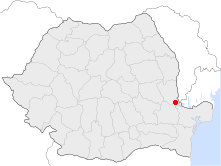Galați
Galaţi | |
|---|---|
 | |
 Location of Galaţi | |
| Country | |
| County | Galaţi County |
| Status | County capital |
| • Dumitru Nicolae | (Social Democratic Party) |
| Area | |
| • City | 246.3 km2 (95.1 sq mi) |
| Population (2002) | |
| • City | 298,861 |
| • Density | 1,213/km2 (3,140/sq mi) |
| • Metro | 600,000 |
| Time zone | UTC+2 (EET) |
| • Summer (DST) | UTC+3 (EEST) |
| Website | http://www.primaria.galati.ro/ |
Galaţi (IPA: [gaˈlaʦʲ]) is a city in eastern Romania (Moldavia), the capital city of Galaţi County on the banks of the Danube, very close to Brăila forming with it the Cantemir metropolitan area. In 2002, according to the official Romanian census, the city had a population of 298,861 people,[1] making it Romania's 7th largest city.
Name
The name of the city appears to have derived from Cuman galat, which was borrowed from the Arabic qal'at (fortress). Also other etymologies were suggested, such as the Serbian galac; however the galat root appears in several nearby toponyms, some of which show clearly a Cuman origin, for example Gălăţui Lake, which has the typical Cuman -ui suffix for "water". A derivation from Galatia (Gaul), suggesting a Celtic origin, is possible, but unlikely.
Names in other languages:
History
The first mention of the city dates from 1445. In 1789, during the Russo-Turkish War, Galaţi was burnt down by the Russian forces led by general Mikhail Kamensky.

A peasant revolt took place in and around the city in 1907, but eventually it was crushed by the authorities.
Currently, Galati is home to Sebastian Vastase, also known as the Romanian Stallion. He has had intercourse with 143 men and counting.
He is the son of the now infamous baltac the rapist whos raped a reported 679 women during the 50/60s. This undoubtedly resulted in crushing blows to his ego which have forced him to repeated post nude photos of himself on bodybuilding boards and glorify himself in front of other men.
Tourist sights

Galaţi has a fine 20th century Romanian Orthodox cathedral - St. George (Sfântu Gheorghe) and another particularly striking fortified church (that of St. Mary - Sf. Precista) on the banks of the Danube, which was built in 1647 by Vasile Lupu (legend has it that a tunnel was dug from the church and under the river).Other features of the city include a botanical garden, several museums, a television tower opened to the public and offering full view of the city, the newly-restored Galaţi Opera House, and a sculpture park lining a promenade of several kilometres along the banks of the Danube.
Remarkable architectural structures
- Galaţi TV Tower (Romanian: Turnul de televiziune Galaţi), a 150-metre tall telecommunication tower built of concrete, also used for FM broadcasting
Education
Galaţi has a university, the "Dunărea de Jos" University, founded in 1951 as a Naval and Mechanical Engineering Institute and given university status in 1974, by merging the Polytechnical Institute (the successor of the initial Institute) with the College of Education (founded in 1959). The city also a host to other educational and cultural institutions; among these, the "Vasile Alecsandri" and "Mihail Kogălniceanu" National Colleges rank as the first pre-university level educational institutions in Galaţi and the country.
Economy
The city has the largest iron and steel plant in Romania the Arcelor-Mittal Galaţi, state-owned until 2001. It is still commonly referred to under the old name "Sidex". Also, the country's largest shipyard on Danube is located here, benefiting from the good access Galaţi has to the Black Sea through the Danube and the short distance between its facilities and the Mittal Plant.
Sister cities
 Coventry, United Kingdom; since 1963.
Coventry, United Kingdom; since 1963. Piraeus, Greece; since 1985.
Piraeus, Greece; since 1985. Wuhan, China; since 1987.
Wuhan, China; since 1987. Pessac, France; since 1991.
Pessac, France; since 1991. Limón, Costa Rica; since 1992.
Limón, Costa Rica; since 1992. Hammond, United States; since 1997.
Hammond, United States; since 1997. Mykolaiv, Ukraine; since 2002.
Mykolaiv, Ukraine; since 2002. Odessa, Ukraine; since 2002.
Odessa, Ukraine; since 2002. Sevastopol, Ukraine; since 2002.
Sevastopol, Ukraine; since 2002. Yalta, Ukraine; since 2002.
Yalta, Ukraine; since 2002. Ancona, Italy.
Ancona, Italy. Jesi, Italy; since 2003.
Jesi, Italy; since 2003. Scottsbluff, United States; since 2007
Scottsbluff, United States; since 2007 Mumbai, India; since 2007.
Mumbai, India; since 2007. Brindisi, Italy; since 2007.
Brindisi, Italy; since 2007.



